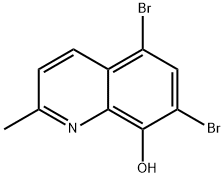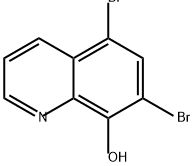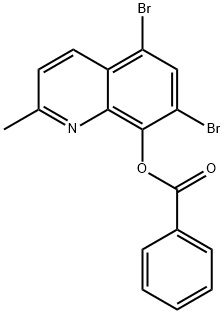5-bromoquinolin-8-ol
- CAS NO.:1198-14-7
- Empirical Formula: C9H6BrNO
- Molecular Weight: 224.05
- MDL number: MFCD00457011
- EINECS: 214-829-2
- SAFETY DATA SHEET (SDS)
- Update Date: 2024-10-28 16:48:35

Properties of 5-bromoquinolin-8-ol
| Melting point: | 127 °C |
| Boiling point: | 362.7±22.0 °C(Predicted) |
| Density | 1.5708 (rough estimate) |
| refractive index | 1.6120 (estimate) |
| storage temp. | Inert atmosphere,Room Temperature |
| pka | 3.77±0.10(Predicted) |
| form | powder to crystal |
| color | White to Orange to Green |
Safety information for 5-bromoquinolin-8-ol
| Signal word | Warning |
| Pictogram(s) |
 Exclamation Mark Irritant GHS07 |
| GHS Hazard Statements |
H315:Skin corrosion/irritation H319:Serious eye damage/eye irritation |
| Precautionary Statement Codes |
P264:Wash hands thoroughly after handling. P264:Wash skin thouroughly after handling. P280:Wear protective gloves/protective clothing/eye protection/face protection. |
Computed Descriptors for 5-bromoquinolin-8-ol
New Products
Tert-butyl bis(2-chloroethyl)carbamate 4-Methylphenylacetic acid N-Boc-D-alaninol N-BOC-D/L-ALANINOL N-octanoyl benzotriazole 3-Morpholino-1-(4-nitrophenyl)-5,6-dihydropyridin- 2(1H)-one Furan-2,5-Dicarboxylic Acid DIETHYL AMINOMALONATE HYDROCHLORIDE 1,1’-CARBONYLDIIMIDAZOLE R-2-BENZYLOXY PROPIONIC ACID 1,1’-CARBONYLDI (1,2-4 TRIAZOLE) N-METHYL INDAZOLE-3-CARBOXYLIC ACID (2-Hydroxyphenyl)acetonitrile 4-Bromopyrazole 5-BROMO-2CYANO PYRIDINE 5,6-Dimethoxyindanone 5-broMo-2-chloro-N-cyclopentylpyriMidin-4-aMine 2-(Cyanocyclohexyl)acetic acid 4-methoxy-3,5-dinitropyridine 1-(4-(aminomethyl)benzyl)urea hydrochloride 2-aminopropyl benzoate hydrochloride diethyl 2-(2-((tertbutoxycarbonyl)amino) ethyl)malonate tert-butyl 4- (ureidomethyl)benzylcarbamate Ethyl-2-chloro((4-methoxyphenyl)hydrazono)acetateRelated products of tetrahydrofuran




![2-[(5,7-dibromoquinolin-8-yl)oxy]propanoic acid](https://img.chemicalbook.in/CAS/20200119/GIF/CB41666931.gif)
![3-[(5,7-dibromoquinolin-8-yl)oxy]propanoic acid](https://img.chemicalbook.in/CAS/20200331/GIF/CB51711386.gif)
![[(5,7-dibromoquinolin-8-yl)oxy]acetic acid](https://img.chemicalbook.in/CAS/20200331/GIF/CB61586280.gif)

You may like
-
 1198-14-7 5-BROMO-8-HYDROXY QUINOLINE 98%View Details
1198-14-7 5-BROMO-8-HYDROXY QUINOLINE 98%View Details
1198-14-7 -
 5-Bromo-8-hydroxyquinoline CAS 1198-14-7View Details
5-Bromo-8-hydroxyquinoline CAS 1198-14-7View Details
1198-14-7 -
 1975-50-4 98%View Details
1975-50-4 98%View Details
1975-50-4 -
 2-HYDROXY BENZYL ALCOHOL 98%View Details
2-HYDROXY BENZYL ALCOHOL 98%View Details
90-01-7 -
 2-Chloro-1,3-Bis(Dimethylamino)Trimethinium Hexafluorophosphate 221615-75-4 98%View Details
2-Chloro-1,3-Bis(Dimethylamino)Trimethinium Hexafluorophosphate 221615-75-4 98%View Details
221615-75-4 -
 14714-50-2 (2-Hydroxyphenyl)acetonitrile 98+View Details
14714-50-2 (2-Hydroxyphenyl)acetonitrile 98+View Details
14714-50-2 -
 118753-70-1 98+View Details
118753-70-1 98+View Details
118753-70-1 -
 733039-20-8 5-broMo-2-chloro-N-cyclopentylpyriMidin-4-aMine 98+View Details
733039-20-8 5-broMo-2-chloro-N-cyclopentylpyriMidin-4-aMine 98+View Details
733039-20-8
Statement: All products displayed on this website are only used for non medical purposes such as industrial applications or scientific research, and cannot be used for clinical diagnosis or treatment of humans or animals. They are not medicinal or edible.